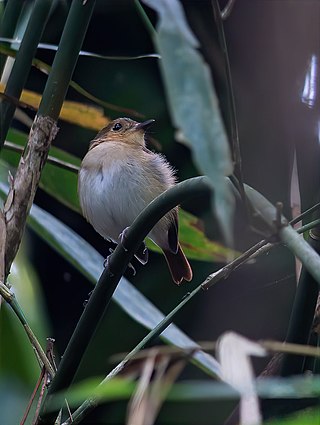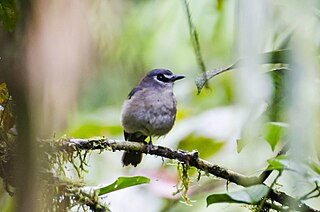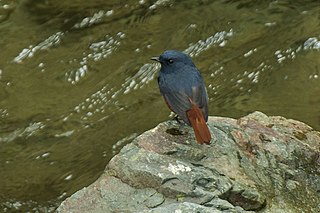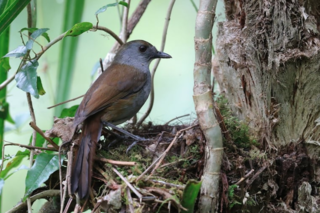
The Palawan blue flycatcher is a species of bird in the family Muscicapidae. It is endemic to the Philippines found only on Palawan and its surrounding islands.

The black-belted flowerpecker or Visayan flowerpecker, is a species of bird in the family Dicaeidae. It is endemic to the Philippines where it is restricted to Panay, Negros and Guimaras islands. It was formerly regarded as a subspecies of the more widespread red-keeled flowerpecker. Sometimes the name red-keeled flowerpecker is used for D. haematostictum and D. australe is then known as the red-sided flowerpecker.

The little slaty flycatcher is a species of bird in the family Muscicapidae. It is found on the islands of Mindanao, Leyte and Samar in the Philippines.

The cryptic flycatcher is a species of bird in the family Muscicapidae. It is endemic to the Philippines only being found in the island of Mindanao. Its natural habitat is tropical moist mid-montane forests from 600 - 1,500 meters.

The white-vented whistler is a species of bird in the family Pachycephalidae. It is found in the southern Philippines and a few islands of Malaysia. Its natural habitats are tropical moist lowland forest and tropical moist montane forest.

The stripe-headed rhabdornis or stripe-headed creeper, also known as the stripe-sided rhabdornis, is a species of bird currently placed in the starling family, Sturnidae. It is endemic to the Philippines.

The brown-chested jungle flycatcher is a species of bird in the Old World flycatcher family Muscicapidae. It breeds in South China and winters in the Malay Peninsula. Its natural habitats are subtropical or tropical moist lowland forests and subtropical or tropical mangrove forests. It is threatened by habitat loss.

The Sula jungle flycatcher is a species of passerine bird in the Old World flycatcher family Muscicapidae. It is endemic to Sula Island in Indonesia where its natural habitat is subtropical or tropical moist lowland forests. It is threatened by habitat loss.

The slaty-backed jungle flycatcher, also known as the Goodfellow's jungle flycatcher or the Mindanao jungle flycatcher is a species of bird in the Old World flycatcher family Muscicapidae. It is endemic to the Philippines found only on the island of Mindanao. The specific epithet honours the British zoological collector Walter Goodfellow. Its natural habitat is tropical moist montane forests. It is threatened by habitat loss

The white-browed jungle flycatcher, also known as the Luzon jungle-flycatcher and the Rusty-flanked jungle-flycatcher, is a species of bird in the Old World flycatcher family Muscicapidae. It is endemic to Luzon island, in the Philippines. The natural habitat of the white-browed jungle flycatcher is tropical moist montane forests of the Cordillera Mountain Range and possibly Sierra Madre Mountains. It is threatened by habitat loss.

The Philippine jungle flycatcher is a species of passerine bird in the Old World flycatcher family Muscicapidae. It is endemic to the Philippines. Its natural habitat is tropical moist lowland forests up to 1,000 meters above sea level.

The Luzon water redstart, also known as the Luzon redstart, is a species of bird in the family Muscicapidae. It is endemic to the Philippines found primarily on Luzon with no records in Mindoro since 1965. Its natural habitats are tropical moist lowland forest, tropical moist montane forest, and rivers. It is threatened by habitat loss.

The Luzon striped babbler is a species of bird in the family Zosteropidae. It is one of the four striped babblers along with the Negros striped babbler, Panay striped babbler and Palawan striped babbler. It is endemic to the Philippines, where it is only found in northern Luzon and in Bataan. Its natural habitat is tropical moist lowland forest. It is threatened by habitat loss.

The blue paradise flycatcher is a species of bird in the family Monarchidae. It is endemic to Palawan. It is mainly found in the understory of lowland primary and secondary forests, however populations are likely to be declining owing to habitat loss.

The Bagobo babbler or Bagobo robin is a monotypic species of bird with its taxonomy undergoing numerous changes and is currently classified as Muscicapidae or an old world flycatcher. It is endemic to the Philippines only found in Mindanao. It was once deemed "unquestionably the Philippines most secretive bird" by ornithologist Robert Kennedy. It habitat are in moist montane forests up to 2,030 meters above sea level. It is named after the Bagobo tribe.

The Visayan bulbul or Steere's bulbul, is a songbird species in the bulbul family, Pycnonotidae.

The Visayan rhabdornis is a species of bird currently placed in the starling family, Sturnidae. It is endemic to the central Philippines on the islands of Negros and Panay. It was previously considered a subspecies of the stripe-breasted rhabdornis. It lives in tropical moist montane forest and is threatened by habitat loss.

The Bundok flycatcher or thicket flycatcher, is a species of bird in the family Muscicapidae. It is endemic to the Philippines found in tropical montane forest.
The Sulu jungle flycatcher is a species of passerine bird in the Old World flycatcher family Muscicapidae. It is endemic to the Sulu Archipelago. Its natural habitat is tropical moist montane forests. While it has yet to be assessed by the International Union for Conservation of Nature, this species is likely threatened by habitat loss.

The Philippine shortwing is a species of bird in the family Muscicapidae. It is endemic to the Philippines where it favours montane forest. It was once conspecific with the White-browed Shortwing.





















